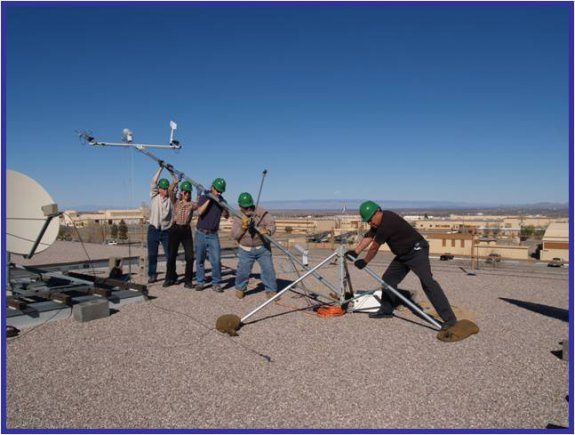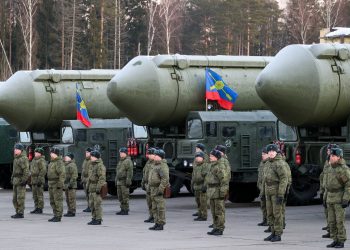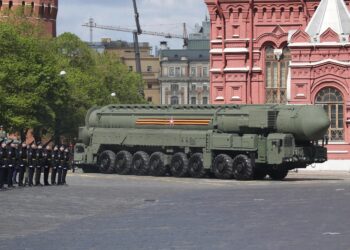A wind monitoring and modeling system being developed by the Army Research Laboratory’s, or ARL, White Sands Missile Range, or WSMR, division could one day protect Soldiers and civilians alike from weapons of mass destruction.
The Local-Rapid Evaluation of Atmospheric Conditions, or L-REAC, system is a computerized weather sensor system under development at ARL intended to help predict the flow of gasses and fumes, or “plumes,” produced by things such as gas leaks and chemical weapons.
Being able to identify how an airborne hazard will behave is a vital ability for first responders to have in order for them to know how to approach or evacuate an affected area.
“If you are a dispatch person and you have to direct first responders to the site, you can look at the wind field and see what the safest approach would be,” said Gail Vaucher, a research meteorologist with ARL at WSMR.
There are other systems available that can predict the plume with some accuracy. Such systems use things like wind speed, air pressure, temperature, and humidity in their calculations. But L-REAC system adds a new layer that previous systems didn’t have. Using terrain data, building plans and dimensions, L-REAC can model and display not only the plume, but the actual airflow around buildings and terrain features.
“We decided to utilize the 3D wind field model developed by Doctor Yansen Wang at ARL Headquarters in Adelphi (Md.) because it had the capability to not only render very quickly, but it can look at many different scales,” said Donald Hoock, chief of the Atmospheric Dynamics Branch of ARL at WSMR.
Thanks to this wind flow model, L-REAC can model how wind will flow when it encounters everything from trees and boulders, to buildings and other structures. While not real-time, the model will update regularly depending on the size of the area being observed.
As air flows around things like buildings, pockets of slower moving or even circular flowing air can be generated on the downwind side, while other formations like alleyways can form wind tunnels. Using L-REAC’s modeling capability, a first responder can predict how these wind effects will alter a plume.
Additionally, L-REAC is a scalable system. The system allows a first responder to monitor large areas, or focus in on a specific incident site. The system uses information about weather and terrain to help build its model.
“The models themselves, in order to be appropriate for an area, need to know about the area, what is the terrain and what is the morphology,” said Vaucher.
For urban areas, Vaucher said, this also includes the shape and size of buildings. In the case of established areas, exact data can be input for detailed results. If detailed information isn’t available, the system will accept less-detailed information if the operator is willing to accept less-detailed results.
“The more details you have, the better the results,” said Vaucher. “If you have a generic description, you’ll get a generic result.”
The L-REAC system collects data from a series of weather monitoring stations that evaluate things like air pressure, temperature, humidity, wind speed, and wind direction. These stations can be the transportable kind like several that ARL has placed around WSMR, or they can be permanent stations like those found at airports or similar facilities.
Since the weather stations and computer systems are largely autonomous, ARL sees military installations and similar facilities as prime examples of where L-REAC could be implemented as part of a force protection plan. On an installation, L-REAC could be installed as a continuously running system, ready for use at a moment’s notice by operation center operators or dispatchers.
“We want to have the capability for them to immediately pull up on their computer screen a picture of what the wind fields are across the post without having to go in and physically start anything running. It would always be running 24-hours a day,” said Hoock.
L-REAC, while still in development, has already seen real-world action. It was used to track and predict smoke and airflow during the Abrams wildfire that threatened WSMR last year.
Ultimately, ARL hopes to have the system integrated with compact mobile weather monitoring systems so first responders and service members can always have a weather station as close to an area of interest as possible.
“The current Army is focusing on short, quick missions, so we want to build a tool that they can use,” said Vaucher.
To make this final mobile component of L-REAC a reality, ARL will need the help of new partners to help fund the integration of mobile sensors into the system. ARL is hoping for partners within the Army and the Department of Defense for integration into force protection plans.
“I think our ultimate goal is to team first on the Army side, and them more on the DOD side, looking for putting L-REAC in at installation levels to begin with,” said Hoock.
Other government organizations and agencies could also easily become partners on the program. Commercial partners would be welcome as well, though the process of establishing a commercial partnership would be more complex.










